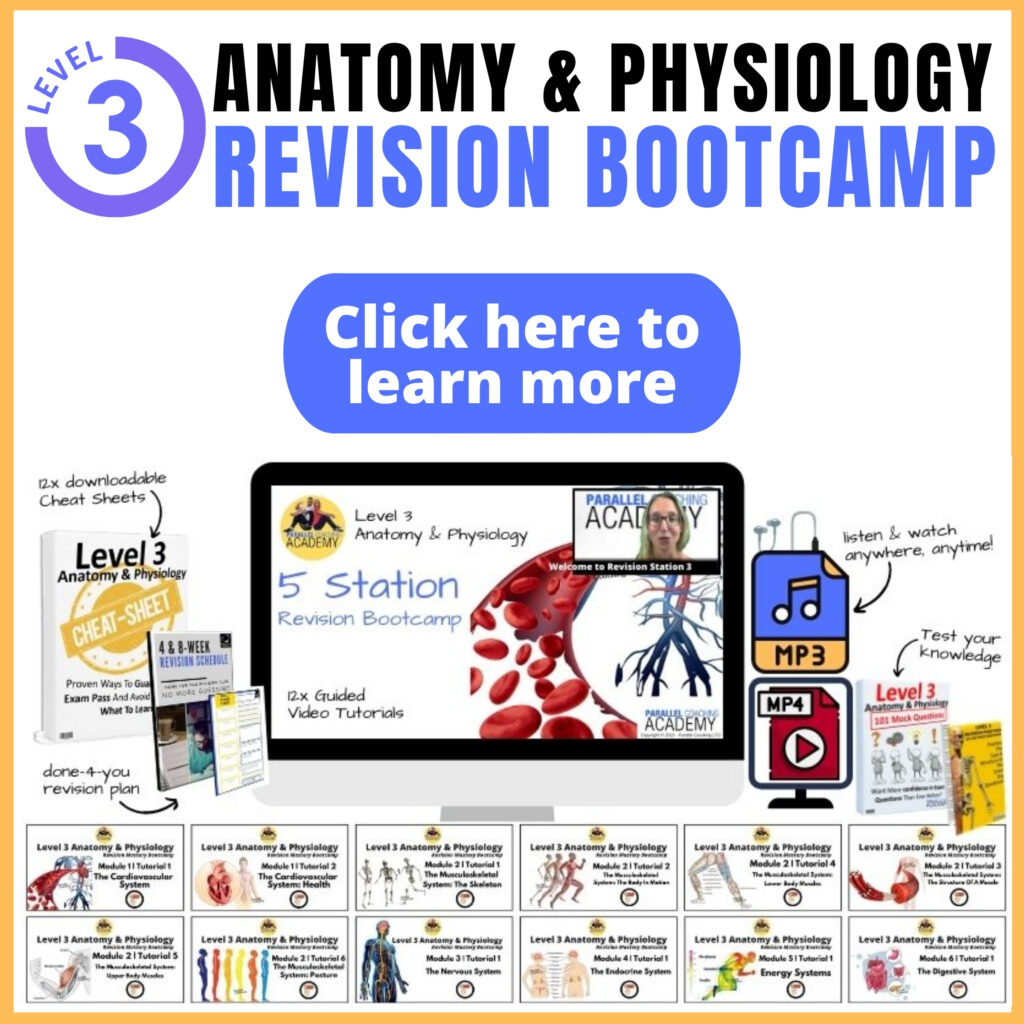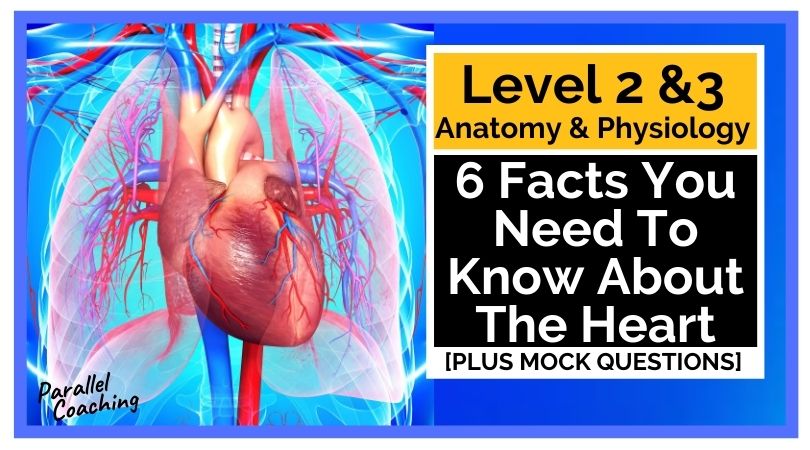In today’s blog, you’ll learn 6 Facts About The Heart, You Need To Know for your Level 2 and Level 3 Anatomy Exam, with an easy breakdown of complex topics and a 20-minute audio podcast to download and revise whilst you are on the move
You’ll discover:
- What to expect in your Level 2 and Level 3 Anatomy Exam
- 6 Facts About The Heart, You Need To Know
- a 20-minute audio podcast to download and revise whilst you are on the move
- Test your knowledge with 3 Mock Questions and answers
What to expect in your Level 2 and Level 3 Anatomy Exam?
The content of each Anatomy exam will vary depending on the level of your study, and your awarding body. However, most Level 2 anatomy exams have 50 multiple-choice questions; and most Level 3 anatomy exams have 40 multiple-choice questions.
The heart is one of eight modules that you need to know in-depth for your Level 2 and Level 3 anatomy and physiology exam. You can expect 3-8 questions all about the heart in each exam.
You need to know 6 facts about the heart in preparation for your Level 2 or 3 Anatomy and Physiology Exam
6 Facts About The Heart, You Need To Know
Here are the 6 facts that you need to be aware of for your exam,
Click the links below to download a 20-minute podcast and learn these 6 facts via audio
Spotify >>> https://open.spotify.com/episode/0V1vbO3rFr2VdPfJVSl6ur?si=6YTfWAxNTYaMKMl4nJDJrg
Tunes >>> https://podcasts.apple.com/gb/podcast/s7-e2-heart-revision-bite/id1485703708?i=1000507398080
FACT 1 = LOCATION
You need to know that the heart is in the thoracic cavity, posterior (behind) the sternum. The heart is the size of a human fist and sits slightly left of centre.
FACT 2 = MUSCLE TYPE
The walls of the heart are “cardiac muscle”. It is the only type of muscle like it in the body, and is involuntary which means that we don’t have to consciously remind it to contract (thank fully). The cardiac muscle is also striated which means it creates a forceful contraction, unlike the arteries and veins that are smooth muscle.
FACT 3 = CHAMBERS
There are four chambers (rooms) inside the heart. Two of these are responsible for collecting blood, these are called Atria. Two of these are responsible for pumping blood, called Ventricles. We have a Left Atria and Left Ventricle that contains oxygenated blood, and a Right Atria and Right Ventricle that contains deoxygenated blood.

FACT 4 = VALVES
There are 2 types of valves in the heart.
Atrioventricular valves separate the Atria (collecting chamber) from the Ventricle (pumping chamber) and prevent the backflow of blood from the ventricle back to the atria. We have these on the left and the right side of the heart. The left side is called a Bi-Cuspid valve. The right side is called the Tricuspid valve.
The semi-lunar valves are strong valves that separate the ventricles from the arteries that exit the heart. These prevent the backflow of blood from the arteries back to the ventricles. The valve in the Left ventricle is called the Aortic Valve as it exits to the aorta. The valve in the Right Ventricle is called the Pulmonary valve as it exits to the Pulmonary Artery.
FACT 5 = AORTA
The Aorta is the biggest artery in the body and is approximately the diameter of a thumb. It is located at the top of the heart and carries Oxygenated blood from the Left Ventricle of the heart to the other arteries of the body.
FACT 6 = BLOOD VESSELS
There are three types of blood vessels:
Arteries always carry blood Away from the heart. Remember this as A = Away A = Arteries.
Veins always carry blood IN to the heart. Remember this as VeIN = IN to heart
Capillaries are the smallest blood vessels, with thin permeable walls that allow for nutrients to be passed from the blood into cells, muscles, lungs etc.
Listen and Learn in 20 minutes
Click the links below to start listening and learning right now:
Spotify >>> https://open.spotify.com/episode/0V1vbO3rFr2VdPfJVSl6ur?si=6YTfWAxNTYaMKMl4nJDJrg
Tunes >>> https://podcasts.apple.com/gb/podcast/s7-e2-heart-revision-bite/id1485703708?i=1000507398080
Look at the Heart Anatomy and Physiology Mock questions below and jot down your answer on scrap paper or as a note in your phone.
Test your knowledge with 3 Mock Questions
Then scroll down to reveal the answers.
1) Which of the following carries blood away from the heart?
A. Capillaries
B. Arteries
C. Veins
D. Semi Lunar Valves
2) Which Characteristics Best describe the type of muscle of the heart?
A. Involuntary and Striated
B. Involuntary and Smooth
C. Voluntary and Striated
D. Voluntary and Smooth
3) How many chambers are in the heart?
A. 1
B. 2
C. 3
D. 4
Answers:
Q1: Answer = B
Q2: Answer = A
Q3: Answer = D
If you want more mock questions like this, then you can download more Free Mock Questions: DOWNLOAD NOW
Need More Help with your Level 3 Anatomy Revision?
For Trainee FITPROS Taking Their L3 Anatomy & Physiology Exam.
Learn, Revise & Pass Your Level 3 Anatomy & Physiology Exam In Under 10 hours
(Without Having To Spend Hours Revising Or Feeling Overwhelmed)
If you want to get your revision structured, learn everything you need to know, and feel confident on exam day, then click the link below:

Dedicated to More
Hayley “6 Facts About The Heart, You Need To Know For L2 and L3 Anatomy” Bergman
Parallel Coaching
P.S. You can also find us on the following platforms:
Instagram: Follow Now
Facebook: Like Our Page
Twitter: Tweet Us
YouTube: Subscribe Here
More Revision Blogs: HERE

